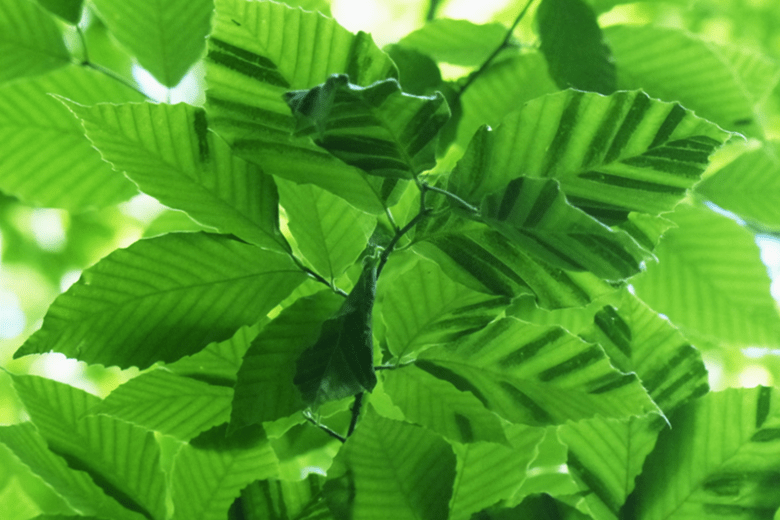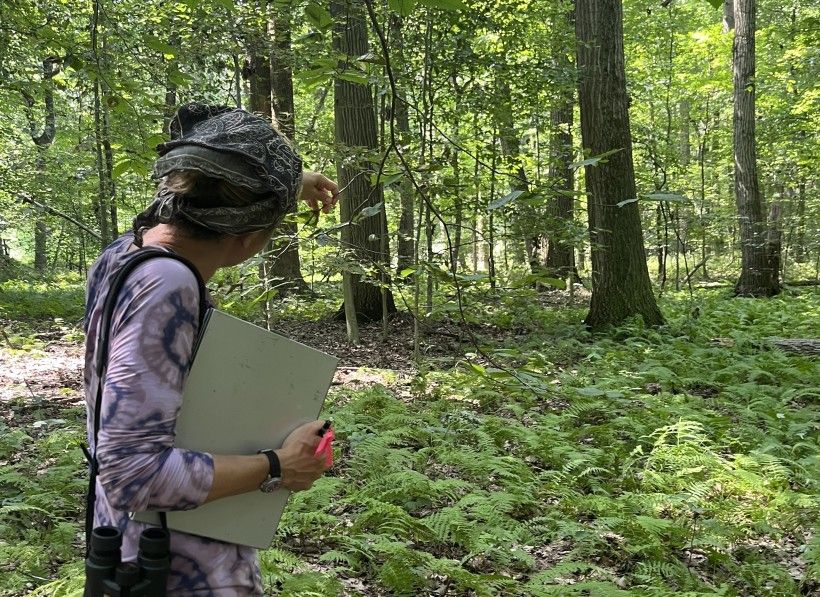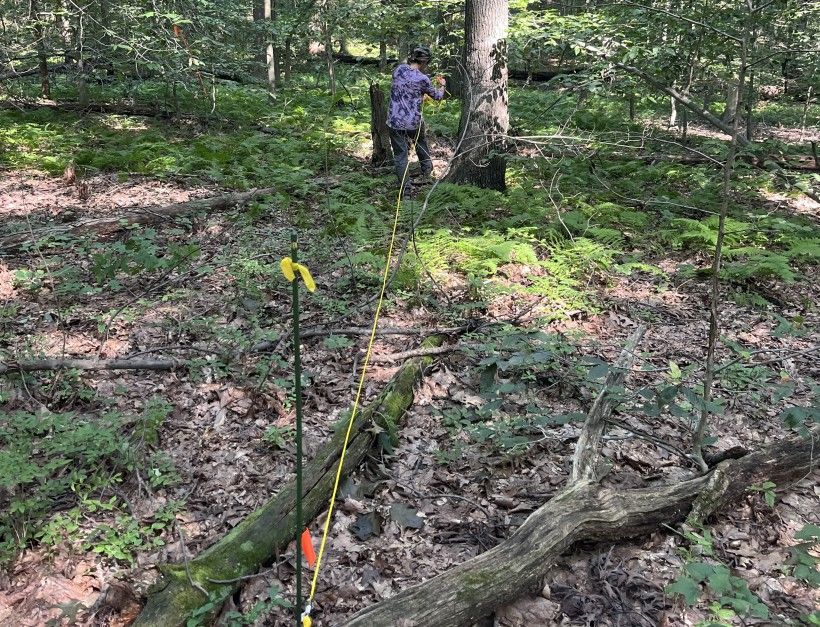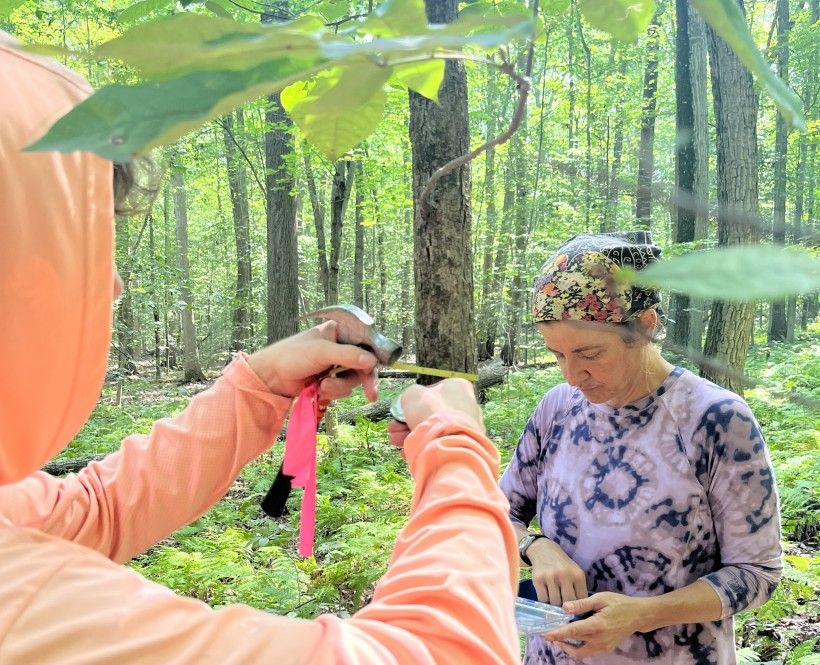Beech Leaf Disease Research at Miller Farm

First observed in Ohio in 2012, Beech Leaf Disease (BLD) has since spread swiftly throughout the northeastern United States, reaching as far as Ontario, Canada. The disease affects seedlings, saplings and mature trees, and is believed to be caused by Litylenchus crenatae mccannii, an invasive nematode—or microscopic worm—that infiltrates the buds and leaves of American beech trees, depriving them of vital nutrients, gradually weakening the host and ultimately leading to its death. BLD poses a serious threat to the health and future of beech-dominant forest ecosystems.
Given that BLD is a recently identified disease, the scientific understanding of its development and progression is limited. Research efforts are taking place by statewide entities such as by the Pennsylvania Department of Conservation & Natural Resources Bureau of Forestry (PA DCNR) and at local levels in Chester County by Dr. Jessica Schedlbauer, Professor of Biology at West Chester University. This summer, Brandywine’s Public Engagement Coordinator, Julia Steiner, joined Dr. Schedlbauer and student Nick Baffa for a morning in the field to learn more about the research efforts aimed at fighting this devastating disease.

Understanding BLD
For at least the next three summers, Schedlbauer will be working at Brandywine Conservancy’s Miller Farm and Birmingham Hill Preserve as well as the University’s Gordon Natural Area to try to learn more about BLD and what can be done to stop it.
Preparation for the field method research involves setting up three 500m2 test plots at each property. Ideal plots include American beech trees of all sizes and ages ranging from saplings to mature canopy trees. The plots must be 150 meters apart from each other and given a 60-meter buffer from the edge of the woodland to reduce impact from meadow management and agricultural farming practices.

After Dr. Schedlbauer and Nick marked off the test plots, they took GPS coordinates using waypoint averaging to determine the exact center point of each plot. All trees within 12-13 meters from the center point of the plot with a trunk diameter of greater than 5 centimeters were measured at diameter at breast height (DBH) and tagged with numbered aluminum plates and nails. There were collectively 26 trees in the first plot.
The next steps involved visually assessing BLD severity on individual trees and branches. This included evaluating crown illumination percentage. The crown is the upper part of a tree, encompassing all its branches, twigs, and leaves. This structure extends outward and upward from the main trunk, forming what is often seen as the tree’s canopy. Crown illumination percentage references how much sunlight reaches the crown of a tree, helping scientists understand how well the tree can grow and compete in a forest. It is assessed by dividing the crown into thirds and determining the percentage of leaves in each third with visual BLD symptoms. They also estimated the total leaf area loss, which is recorded as a percentage. Any portions of the crown not visible from the ground are marked as such.
Dr. Schedlbauer shared that over time, measurements including hemispherical photographs will be taken at each plot center to track changes in canopy cover and light availability in the understory. They additionally hope to identify climatic factors like heavy rain and low temperature associated with disease progression, to gain a better understanding of the speed of disease progression in trees of different sizes. As American beech trees begin to die, Dr. Schedlbauer and her students will also be able to monitor growth rates of the remaining trees in each plot.

Next Steps
In summer 2026, they are slated to do a set of leaf-level photosynthesis and respiration measurements. The hope is that these precise measurements will offer a window into a better understanding of the plant’s metabolic health under the stress of BLD. By zooming in at the leaf level, there is potential to detect subtle changes that might not be visible at the whole-plant scale.
Learn more about Beech Leaf Disease: https://www.brandywine.org/conservancy/blog/beech-leaf-disease-coming-your-way
Past research projects conducted by Dr. Jessica Schedlbauer at Brandywine’s Miller Farm can be found here:
- Schedlbauer, J.L. & S. Paynter. 2025. Photosynthetic induction and sunfleck responses of three understory tree species in forests of the Mid-Atlantic U.S. Trees – Structure and Function 39:35, https://doi.org/10.1007/s00468-025-02611-3
- Schedlbauer, J.L. & J. Miller. 2022. Edge effects increase soil respiration without altering soil carbon stocks in temperate broadleaf forests. Ecosphere 13(6):e4092, https://doi.org/10.1002/ecs2.4092
Resources
Rose, Jill, John Nissen, and Kendra McMillin. Beech Leaf Disease and Forest Health in Pennsylvania. Pennsylvania Department of Conservation & Natural Resources, Bureau of Forestry, 17 June 2025. PowerPoint presentation.